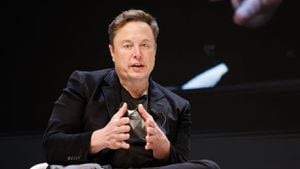Imagine living in a world where you can 3D-print critical supplies while floating in space, safely navigate the heavens despite the ever-growing clutter of space debris, or even sip cocktails at the edge of Earth's atmosphere. These scenarios are not distant mirages; they are right around the corner, thanks to the relentless surge of space-bound innovation.
In recent months, breakthroughs in space technology have captured headlines and imaginations. From the successful tests of a pioneering microgravity 3D printer to SpaceX's preparations for their fifth Starship test flight, and China's meticulous fortification of their space station, the aerospace landscape is rapidly evolving. Not to mention, a fresh contender in space tourism is raising the stakes, promising a luxurious stratospheric journey that's set to redefine the boundaries of adventure travel.
Let’s dive into these fascinating developments, starting with the remarkable achievements in microgravity 3D-printing.
Scientists at the University of California, Berkeley, have successfully tested the SpaceCAL 3D printer, a next-gen device designed to operate in the harsh environment of microgravity. This milestone was part of the Virgin Galactic 07 mission, which launched in June. During a brief 140-second trial run, the SpaceCAL printer produced several objects from a liquid plastic called PEGDA, including space shuttle models and small benchmark tugboats known as 'Benchys.'
Adapting traditional 3D-printing techniques for space usage is no small feat. The SpaceCAL printer, which descends from the groundbreaking computed axial lithography (CAL) technology, uses light to solidify patterns in a photosensitive resin, rapidly creating intricate 3D structures. This method stands in stark contrast to conventional 3D printers, which rely on building up layers from the bottom. Remarkably, SpaceCAL has the potential to produce objects in as little as 20 seconds, a significant enhancement over the hours typically required for similar tasks.
'SpaceCAL performed well under microgravity conditions in post tests aboard parabolic flights, but it still had something to prove,' explained Taylor Weddell, a Ph.D. student and contributing researcher on the project. 'This latest mission allowed us to validate the readiness of this 3D printing technology for space travel.'
The implications of SpaceCAL’s success are vast. With the ability to manufacture custom parts, tools, and even medical equipment on-site, future space missions could become more self-sufficient. 'If your spacecraft is breaking down, you can print O-rings, mechanical mounts, or even tools,' added Weddell. Further advancements in 3D bioprinting could mean producing replacement organs or tissue, enhancing emergency medicine for astronauts.
This brings us to SpaceX, a name synonymous with space exploration and pioneering advancements. Recently, SpaceX rolled out its Starship megarocket's colossal first-stage booster, commonly known as Super Heavy, to the launch pad at their Starbase facility in Texas. The upcoming fifth flight of the Starship is eagerly anticipated, with some groundbreaking goals on the horizon.
The Starship, standing at an impressive 400 feet, is the most powerful rocket ever built. SpaceX considers it a game-changer for space travel, potentially making missions like Mars settlements economically viable. The first four test flights, carried out over the past year, have been incremental steps towards this vision. While the debut flight witnessed an early controlled detonation due to stage separation failure, subsequent flights showcased improved performance, culminating in a fully successful fourth mission.
Flight 5 aims to push boundaries further, potentially incorporating a new technique to catch the Super Heavy booster using the 'chopstick' arms of Starbase's giant launch tower. Elon Musk, SpaceX’s founder and CEO, has hinted at this possibility, aiming for a late July launch.
Shifting gears to another corner of the globe, China has been vigilant in ensuring the longevity and safety of their Tiangong space station. In response to a surge in space debris from a disintegrated Russian satellite, Chinese astronauts undertook a crucial spacewalk, armoring the station against potential impacts. The astronauts, Li Cong and Ye Guangfu, installed protective devices on external cables and pipelines, a task that spanned a grueling 6.5 hours.
'The spacewalk primarily focused on installing protective devices to mitigate risks posed by potential space debris collisions, enhancing the long-term safety and stability of the space station,' shared Liu Ming, an engineer from the China Aerospace Science and Technology Corporation.
This proactive approach stems from the dangers posed by even the tiniest fragments of space debris, underscored by past incidents that forced International Space Station astronauts to take shelter. The Tiangong station's defenses are part of a broader strategy to tackle this growing issue, echoing global efforts to devise innovative solutions against space junk hazards.
On a lighter and more commercial note, the race to commercialize space tourism is gaining momentum. EOS-X Space, a Spanish company, is making waves with its ambitious plans to float tourists to the stratosphere in a luxurious balloon capsule by 2025. Unlike traditional rocket-based voyages, these balloon capsules promise a gentle ascent to nearly 25 miles up, offering breathtaking views of Earth's curvature without the need for elaborate space suits.
EOS-X Space’s capsule, made from pressurized carbon fiber, will accommodate seven passengers and a pilot, providing a lavish experience complete with ergonomic seats, panoramic windows, mood lighting, and even an onboard bar. The entire journey spans five hours, including a serene two-hour cruise at peak altitude.
This high-end form of space tourism comes with a substantial price tag—ranging from $160,550 to $214,060 per person. While certainly an extravagant ticket, CEO Kemel Kharbachi envisions a future where such experiences become more accessible. 'This is the democratization of space travel. In the next decade, it will be more affordable, and we will be there for that,' he stated.
Finally, back on Earth, the U.S. Office of Space Commerce (OSC) is nearing a critical milestone with its long-awaited beta test of the Traffic Coordination System for Space (TraCSS). This initiative aims to streamline space situational awareness and traffic coordination for civil and commercial operators. Transitioning these responsibilities from the Department of Defense to a civilian agency is a complex but necessary step to foster a robust commercial space services industry.
Janice Starzyk, OSC’s deputy director, acknowledged the program's hurdles, particularly in navigating governmental bureaucracy and establishing universal standards for space conjunction data. 'This is a pretty tough program,' she admitted. However, the potential benefits of TraCSS—enhanced collision avoidance, more frequent conjunction scanning, and the integration of commercial data—are too significant to overlook.
'We’re setting up a mini commercial system to understand how to use commercial data and how providers can work together,' Starzyk elaborated. This collaborative approach is essential as space traffic data becomes increasingly diversified, not just among U.S. agencies but globally.
As we gaze at the stars and ponder our place in the vastness of space, these developments remind us that humanity’s next frontier is both thrilling and fraught with challenges. The confluence of technology, international cooperation, and commercial ambition will invariably shape our cosmic future. As SpaceCAL’s Weddell aptly said, 'These experiments are really focused on pushing technology for the betterment of everyone. Even though it’s for space, there are always tons of ways it can benefit people back here on Earth.'



